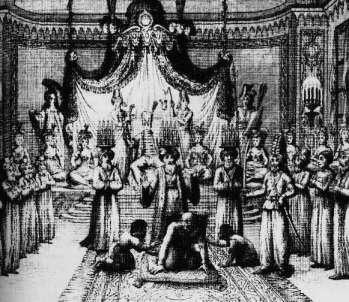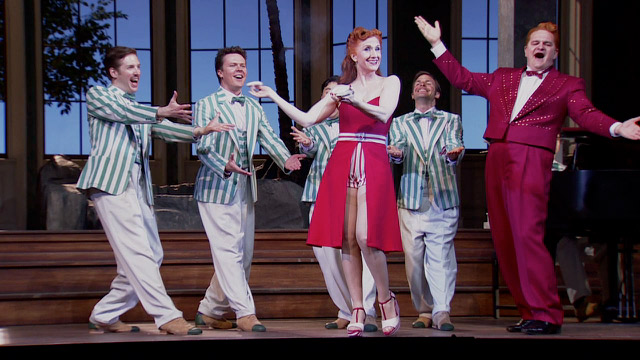A few days later, as usual, I read what had been said about the show, and to tell the truth I was quite stunned reading some of the critics: they seemed to hate it. The Telegraph's review was very negative, mostly because of the stage direction (as were other reviews, but here I reply to this particular one). I think it is an unfair critique that missed the point. Before explaining this position, I want to give some background information.
Ariadne auf Naxos is an opera in two acts staging a story (a music show) within a story (a rich man commissioning to two groups of musicians a music show). As such, we easily understand it is an operatic mise en abîme.
 |
| Poster of the original production in 1912 |
Strauss's work begins with a prologue in a mansion where two troupes of musicians (one comic, one operatic) are commissioned by the master of the house to deliver a music show for his invitees. However, due to delays in the guests' dinner, both shows have to be performed simultaneously. "The horror, the horror," the opera composer gets angry, frustrated, shouts, but resigns. In the second act, the compromised opera is staged; it consists of a patchwork of the two originally commissioned works. It is a farce gathering all the basic ingredients of the operatic genre: a lonely princess who is sad because she was dumped by her lover, magical creatures, a comedy troupe trying to entertain the sad princess, a God that falls in love with Ariadne who chooses to love him in return. It ends with a love duet, of course. It is usually said that Ariadne is about the intertwining of low art and high art.
Concerning Glyndebourne's production, critics usually disagreed with the stage direction. For instance Christiansen (just to name one) thought it was "only a bright decorative idea", "establish[ing] a series of resonances without basis in the text". According the Telegraph's critic, "it is a morbid ailment" where "apparently innocent operas are proved guilty of crimes of which their composers and librettists never dreamed, to the dismay and bafflement of audiences."
The idea of the director, Katharina Thoma, was quite simple and actually quite smart. In the first act, we see the two groups of musicians in a beautiful mansion, but unfortunately, because of the war and bombings, they have to perform at the same time. In the second act, the beautiful mansion is turned into a nursery and the musicians/comedians/dancers have to entertain the wounded, who also take part in the production. Apparently Christiansen didn't like the war, he didn't like the bombs, he didn't like the requisitioned stately home, he didn't like Zerbinetta being a nymphomaniac, etc.
Before explaining to mister Christensen that this reading of the opera is not a "decorative idea [...] without basis in the text", let us not forget that Ariadne auf Naxos was originally planned as part of Hofmannsthal's adaptation of Molière's Bourgeois Gentilhomme, which is a comédie-ballet, a royal entertainment intended to please and where Molière specifically explored the links between comedy, dance, and music. In some sense, Molière aimed at transforming low art into high art.
 |
| Cover of the original version of Molière's Bourgeois Gentilhomme |
- Writing a piece mixing music, dance, and comedy, aimed at entertaining the audience (at least partly), combining both low art and high art. It is the case here because Ariadne is about group of musicians presenting an opera and a troupe of comedians and dancers.
- Re-creating a work that already exists. Ariadne is a re-creation of Molière's work, and features a wannabe character (the composer, echoing Molière's Monsieur Jourdain); actors (the comedians, echoing the grand mamamouchi); musicians and dancers (this is obvious in both works); some references to somewhere far and exotic (the divinities/the Turks); and in the background an institution that is targeted (the opera world/the French bourgeoisie/aristocracy). Ariadne also stages the re-creation of an opera, where two troupes perform at the same time and merge their works.
 |
| The Turks' dance in Molière's play |
In a nutshell then, Ariadne auf Naxos is a re-creation that talks about opera and talks about high art and low art, as is Thoma's work.
Re-creation for Molière meant transforming low art (royal entertainment whose function as only to please the king) into high art, shaping simple material into more evolved forms without forgetting that récreation also means entertainment. Strauss and Hofmannsthal follow this tradition though reversed, as they intended to make high art as accessible as low art. Katharina Thoma's work embodies wonderfully this idea showcasing a thrilling, passionate, and fun work around an moment in history that speaks to a 2013 audience: the second world war. To some extent, it also alludes to the morals of relationship and sexuality, which I guess is a pretty contemporary issue.
 |
| Thoma's production at Glyndebourne in May/June 2013 |
 |
| Thoma's direction at Glyndebourne in May/June 2013 |
I would hope that Mr Christiansen might reconsider his views about Katharina Thoma's work after reading this post and about what stage direction should be. The first function of opera is to entertain, and the high art/low art debate is all about this function. If audience is suppressed from references that are understandable, opera is locked into a very elitist form. I am not sure that this is what we want, at least this is not what I want because I think there is so much in opera, and in classical music in general, that would make people much happier.
Finally, to end this post, just a lovely image. In Thoma's work, the final love duet is followed by a silent scene where the composer smiles alone on stage. He is happy about what has been premiered, and he finds peace. The composer, Richard Strauss, finds peace after refusing to give help during the war (he probably had very good reasons, I'm not judging, but he probably thought back at it) because his work rewrites his own history. The composer, in the play, finds peace because in the end his work was not betrayed after merging with the comedy troupe, acknowledging that this burlesque patchwork was a success. Katharina Thoma's direction at Glynedbourne was similarly a success.
ps: David Nice wrote a cool post about the production too: here.

No comments:
Post a Comment